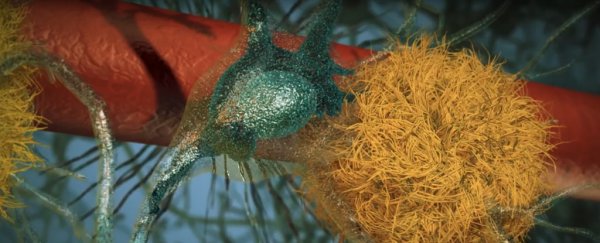Back in 2015, Australian scientists discovered bursts of ultrasound could be used to reverse the symptoms of Alzheimer's disease in mice.
Now, new research has found that if the ultrasound is combined with immunotherapy, the treatment could even more effectively help the body clean up toxic deposits of the proteins responsible for the disease - reducing its debilitating symptoms and potentially opening the way to better treatments.
Researchers from the Queensland Brain Institute (QBI) in Australia have continued their investigation into using ultrasound to administer more antibodies that could clean up the misbehaving proteins that give rise to various neurodegenerative conditions.
Alzheimer's disease is a form of dementia characterised by short term memory loss that gradually worsens over time, caused primarily by a build-up of a protein called beta-amyloid, as well as clumps of another protein called tau, causing brain 'helper' cells to bend into what's called neurofibrillary tangles.
Tau helps give cell's scaffold some rigidity, keeping them nice and straight. In Alzheimer's, the brain cells responsible for supplying neurons with nutrients have tau proteins that form clumps, causing the cells they usually keep straight to collapse.
While it's not entirely clear how this pair of traits develops in the first place, or what role the neurofibrillary tangles play in the disease, researchers have found they can reduce the toxic effects of the beta-amyloid build-up by also targeting the tau proteins with specific antibodies and triggering the immune system into removing them.
The only issue is getting the antibodies to the tau requires them to first cross a membrane that separates blood from brain tissue called the blood-brain barrier, and then having them get inside the cells.
"With vaccination trials in dementia currently ongoing elsewhere, the problem is that only 0.1 percent of the therapeutic antibodies enter the brain, which would make a potential treatment for Alzheimer's very costly," said director Jürgen Götz.
Two years ago, researchers from QBI found ultrasound offered a non-invasive, drug-free way of removing beta-amyloid plaques, at least in mice.
Scientists injected microscopic bubbles into transgenic mice and then focussed bursts of ultrasound on their brains, causing the tiny bubbles to expand and contract rapidly, which in turn forced the walls of the surrounding blood vessel to 'leak'.
This temporary gap in the blood-brain barrier allows antibodies to cross from the blood into the brain, which then helped alert specialised cells called microglia into gobbling up the amyloid proteins.
In this follow-up study, the team again used the technique to jiggle the blood-brain barrier open with ultrasound, this time while introducing antibodies that would seek out the tau proteins.
Their results showed not only more antibodies being taken up by cells in the brain, but a decrease in the clumping form of the tau protein and an overall decrease in the levels of anxiety shown by mice placed into a maze.
Before we get too excited, this new study also used transgenic mice as test subjects instead of humans, raising questions of whether the same technique could scale up and apply to our biology.
Nonetheless, there's hope that by unlocking the blood-brain barrier, other forms of immunotherapy could also be given a helping hand, paving the way to treating other neurological conditions such as Parkinson's disease.
With antibody therapies costing between AU$25,000 and $100,000 every year in Australia, the team hope the use of ultrasound could help reduce the costs of treatment.
Nearly 44 million people around the globe are estimated to be affected by Alzheimer's and related forms of dementia, and the condition ranks as the top cause of disability among the elderly, a number that's set to rise as our population ages.
Let's hope we can see research like this jump from mice to humans soon.
This research was published in Brain.
